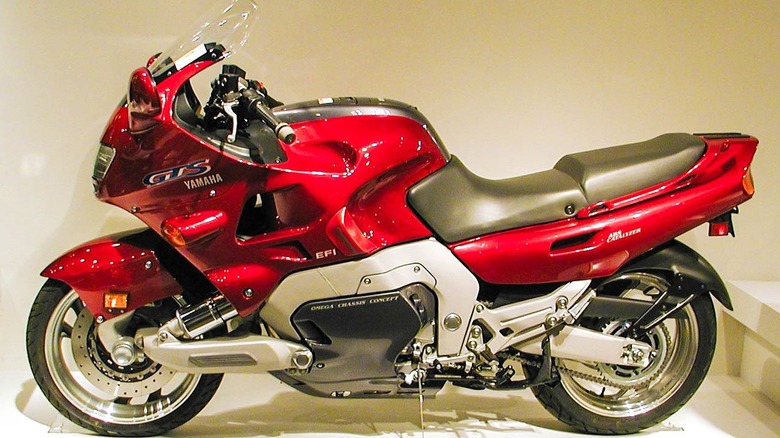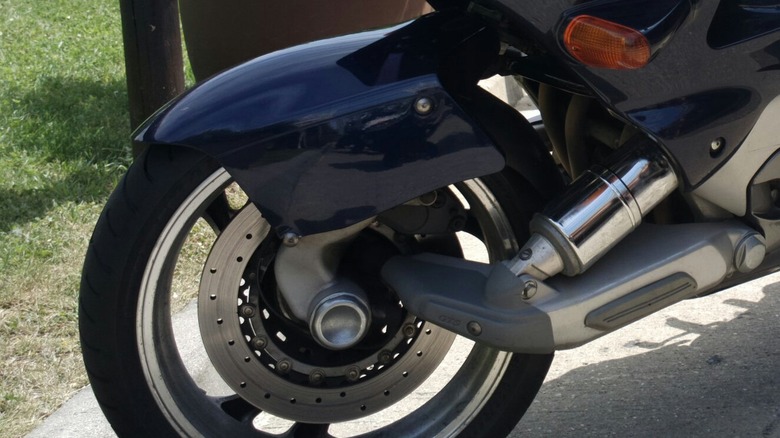Here's What Made The Yamaha GTS1000 Remarkably Futuristic In 1993
Yamaha introduced the much-awaited replacement for its FJ 1100/FJ 1200 in 1993, the Yamaha GTS1000, as a sport-touring bike like no other. The FJ 1100 first came to market in 1984, and the FJ 1200 arrived in showrooms by 1986. But as the 1990s came to the horizon, Yamaha wanted the FJ 1200's successor to be the flagship in the brand's portfolio — a genuine sport-touring bike with a technologically advanced feature unlike you've seen before (per Motorcycle Classics).
Cycle World called the Yamaha GTS1000 a "forkless wonder" and "a major leap forward in motorcycle design." Powered by a detuned 1,002cc liquid-cooled, inline four-cylinder engine derived from Yamaha's FZR1000 sport bike with double overhead camshafts (DOHC), 20 valves, and throttle-body fuel injection, the GTS1000 has 100 horsepower and 78 lb-ft of torque at its disposal. Despite the engine's fantastic low and midrange pull, it's not the most remarkable and futuristic component in Yamaha's state-of-the-art bike.
Forkless RADD front end
What made the Yamaha GTS1000 stand out is its radical forkless front end — a quirky departure from conventional motorcycle design. We're all used to two or three-wheeled wonders like bicycles and motorcycles having a standard fork to hold the front wheel, suspension, and handlebars in place, but the Yamaha GTS1000 has none of that. It was the first production motorbike equipped with a RADD (Rationally Advanced Design Development) front suspension. Besides giving the motorcycle a hi-tech, out-of-this-world vibe, Cycle World adds the RADD design separates the steering from the suspension system, giving the bike a lower center of gravity and better handling.
However, Yamaha didn't invent the RADD suspension. Credit goes to American inventor James Parker, who patented the design in 1985. According to an interview republished by Motorcycle Classics, Parker started working on a RADD-equipped motorcycle prototype in 1983, and patented it in 1985. Parker adds the RADD suspension acts directly on the frame, and the pivoting system delivers a smoother ride. Yamaha patented the design in 1990, and adapted it for a Yamaha GTS1000 prototype by 1992.
Omega chassis design
According to Rider Magazine, the single-sided RADD suspension design enhances steering rigidity, eliminates bump steer, and prevents the bike from diving under heavy braking since the suspension remains independent of the steering mechanism. Moreover, the radical front suspension design enabled Yamaha to develop the Omega chassis architecture — essentially a pair of C-shaped aluminum plates with two steel subframes for the front and back (per Motorcycle Classics).
The bike was brimming with never-before-seen features that Rider Magazine gave the Yamaha GTS1000 its 1993 Bike of The Year award. However, it failed to stir the riding public's imagination upon debuting in 1993. Motorcycle Classics adds that Yamaha sold fewer than 500 units in 1993, probably due to its sub-$15,000 price tag and complex styling. The GTS1000 left the US market in 1994, but Yamaha continued selling the bike in other markets until 1998.
In a 2020 article by Forbes, the publication claims the Yamaha GTS1000 has become a "sought-after modern classic" and would fare well as a future electric motorcycle. It's not a terrible idea, and Yamaha could take a bold step and revive the GT1000's most remarkable feature for the next generation of riders to enjoy.


